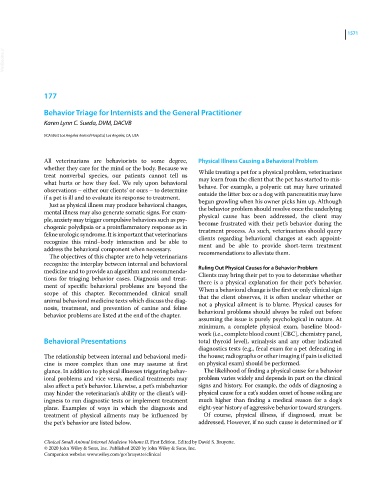Page 1633 - Clinical Small Animal Internal Medicine
P. 1633
1571
VetBooks.ir
177
Behavior Triage for Internists and the General Practitioner
Karen Lynn C. Sueda, DVM, DACVB
VCA West Los Angeles Animal Hospital, Los Angeles, CA, USA
All veterinarians are behaviorists to some degree, Physical Illness Causing a Behavioral Problem
whether they care for the mind or the body. Because we While treating a pet for a physical problem, veterinarians
treat nonverbal species, our patients cannot tell us may learn from the client that the pet has started to mis-
what hurts or how they feel. We rely upon behavioral behave. For example, a polyuric cat may have urinated
observations – either our clients’ or ours – to determine outside the litter box or a dog with pancreatitis may have
if a pet is ill and to evaluate its response to treatment. begun growling when his owner picks him up. Although
Just as physical illness may produce behavioral changes,
mental illness may also generate somatic signs. For exam- the behavior problem should resolve once the underlying
physical cause has been addressed, the client may
ple, anxiety may trigger compulsive behaviors such as psy- become frustrated with their pet’s behavior during the
chogenic polydipsia or a proinflammatory response as in treatment process. As such, veterinarians should query
feline urologic syndrome. It is important that veterinarians clients regarding behavioral changes at each appoint-
recognize this mind–body interaction and be able to ment and be able to provide short‐term treatment
address the behavioral component when necessary. recommendations to alleviate them.
The objectives of this chapter are to help veterinarians
recognize the interplay between internal and behavioral Ruling Out Physical Causes for a Behavior Problem
medicine and to provide an algorithm and recommenda- Clients may bring their pet to you to determine whether
tions for triaging behavior cases. Diagnosis and treat- there is a physical explanation for their pet’s behavior.
ment of specific behavioral problems are beyond the When a behavioral change is the first or only clinical sign
scope of this chapter. Recommended clinical small that the client observes, it is often unclear whether or
animal behavioral medicine texts which discuss the diag- not a physical ailment is to blame. Physical causes for
nosis, treatment, and prevention of canine and feline behavioral problems should always be ruled out before
behavior problems are listed at the end of the chapter.
assuming the issue is purely psychological in nature. At
minimum, a complete physical exam, baseline blood-
work (i.e., complete blood count [CBC], chemistry panel,
Behavioral Presentations total thyroid level), urinalysis and any other indicated
diagnostics tests (e.g., fecal exam for a pet defecating in
The relationship between internal and behavioral medi- the house; radiographs or other imaging if pain is elicited
cine is more complex than one may assume at first on physical exam) should be performed.
glance. In addition to physical illnesses triggering behav- The likelihood of finding a physical cause for a behavior
ioral problems and vice versa, medical treatments may problem varies widely and depends in part on the clinical
also affect a pet’s behavior. Likewise, a pet’s misbehavior signs and history. For example, the odds of diagnosing a
may hinder the veterinarian’s ability or the client’s will- physical cause for a cat’s sudden onset of house soiling are
ingness to run diagnostic tests or implement treatment much higher than finding a medical reason for a dog’s
plans. Examples of ways in which the diagnosis and eight‐year history of aggressive behavior toward strangers.
treatment of physical ailments may be influenced by Of course, physical illness, if diagnosed, must be
the pet’s behavior are listed below. addressed. However, if no such cause is determined or if
Clinical Small Animal Internal Medicine Volume II, First Edition. Edited by David S. Bruyette.
© 2020 John Wiley & Sons, Inc. Published 2020 by John Wiley & Sons, Inc.
Companion website: www.wiley.com/go/bruyette/clinical

